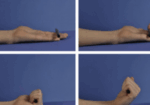THE SENSITIVITY AND SPECIFICITY OF ULTRASOUND FOR THE DIAGNOSIS OF CARPAL TUNNEL SYNDROME: A META-ANALYSIS
Filed under Diagnoses
Fowler, J. R., Gaughan J. P., & Ilyas, A.M. (2011). The sensitivity and specificity of ultrasound for the diagnosis of carpal tunnel syndrome: A meta-analysis. Clinical Orthopedics and Related Research, 469(4), 1089-1094.
The Skinny –The authors sought out to determine the sensitivity and specificity of ultrasound therapy for the diagnosis of carpal tunnel syndrome using three scenarios. 1.) using all studies regardless of reference standard 2.) using all studies with electrodiagnostic as the reference standards and 3.) using all studies with clinical diagnosis as the gold standard.
In the Weeds – The authors found a total of 19 articles that were included in the review. Remember, sensitivity indicates a true positive rate and specificity indicates a true-negative rate.
They found the sensitivity and specificity of ultrasound was 77.6% (71.6%-83.6%) and 86.8% (78.9%-94.8%), respectively.
They found the sensitivity and specificity of electrodiagnostic testing to be 80.2% (71.3-89.0) and 78.7% (66.4-91.1, respectively).
Bringing it Home– Ultrasound showed a higher specificity but electrodiagnostic had a slightly higher sensitivity. Although ultrasound may not replace electrodiagnostic testing as the most sensitive tool for diagnosing carpal tunnel, it may be a feasible alternative to electrodiagnostic testing as a first line confirmatory test.
Overall a very nicely done study however it was not without its limitation. There was a lack of heterogeneity among the studies reviewed. Both, ultrasound and electrodiagnostic testing it very operator dependent. The upside of ultrasound is it can be performed very quickly, it is often less expensive, and off course it is essentially pain-free.
–
More To Read
Video Augmented Hand Therapy after CVA with hemiplegia.
The previous rapid review discussed the positive outcomes of video-augmented hand therapy after a CVA with hemiplegia. Please watch this vlog to discover how to make the video augmented box to make it easily integrated into your clinic. Video By: Shannon Skowbo
Read MoreHand Therapy: How to Treat the Client with a New Distal Radius Fracture
A short blog post on the basics of treating a Distal Radius Fracture.
Read MoreWhat is Chronic Exertional Compartment Syndrome? Overview and Hand Therapy Treatment Ideas
Compartment syndrome is a condition characterized by increased pressure within a compartment of the body, leading to pain, swelling, and reduced tissue perfusion (Barkay et al., 2021; Buerba et al., 2019). It can be either acute or chronic (Barkay et al., 2021). Chronic exertional compartment syndrome (CECS) is a rare type, most commonly observed in…
Read MoreIs HEP Just as Good as Therapy for Metacarpal Fracture Rehab?
Gülke, J., Leopold, B., Grözinger, D., Drews, B., Paschke, S., & Wachter, N. J. (2018). Postoperative treatment of metacarpal fractures – Classical physical therapy compared with a home exercise program. Journal of Hand Therapy, 31(1), 20-28. The Skinny – Medicine is moving towards a model that encourages less direct intervention and a more DIY focus…
Read MoreSign-up to Get Updates Straight to Your Inbox!
Sign up with us and we will send you regular blog posts on everything hand therapy, notices every time we upload new videos and tutorials, along with handout, protocols, and other useful information.






